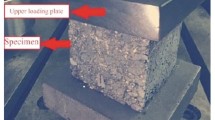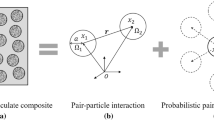Abstract
The high-temperature creep behavior of asphalt mixture was investigated based on micromechanical modeling and virtual test by using three-dimensional discrete element method (DEM). A user-defined micromechanical model of asphalt mixture was established after analyzing the irregular shape and gradation of coarse aggregates, the viscoelastic property of asphalt mastic, and the random distribution of air voids within the asphalt mixture. Virtual uniaxial static creep test at 60 °C was conducted by using Particle Flow Code in three dimensions (PFC3D) and was validated by laboratory test. Based on virtual creep test, the micromechanical characteristics between aggregates, within asphalt mastic, and between aggregate and asphalt mastic were analyzed for the asphalt mixture. It is proved that the virtual test based on the micromechanical model can efficiently predict the creep deformation of asphalt mixture. And the high-temperature behavior of asphalt mixture was characterized from micromechanical perspective.
Similar content being viewed by others
References
Ma T, Huang XM, Zhao YL. Degradation Behaviour Analysis of SMA Aggregate and Skeleton[J]. Journal of Wuhan University of Technology-Materials Science Edition, 2013, 28(6): 1140–1145
Ma T, Ding XH, Zhang DY, et al. Experimental Study of Recycled Asphalt Concrete Modified by High-modulus Agent[J]. Construction and Building Materials, 2016, 128: 128–135
Wu SP, Ye QS, Li N, et al. Effects of Fibers on the Dynamic Properties of Asphalt Mixtures[J]. Journal of Wuhan University of Technology-Materials Science Edition, 2007, 22(4): 733–736
Huang XM, Zhang YQ. A New Creep Test Method for Asphalt Mixtures[J]. Road Materials and Pavement Design, 2010, 11(4): 969–991
Zhao YL, Zhang JP. A Mechanical Model for Three-phase Permanent Deformation of Asphalt Mixture under Repeated Load[J]. Journal of Wuhan University of Technology-Materials Science Edition, 2009, 24(6): 1001–1003
Liao GY, Yang Y, Huang XM, et al. Permanent Deformation Response Parameters of Asphalt Mixtures for A New Mix-confined Repeated Load Test[J]. Journal of Central University, 2013, 20(5): 1434–1442
Cundall PA. A Computer Model for Simulating Progressive Large Scale Movements in Blocky Rock Systems[C]. In: Proceedings of the Symposium of International Society of Rock Mechanics, Nancy, 1971, 2–8
Cundall PA, Strack ODL. Discrete Numerical Model for Granular Assemblies[J]. Geotechnique, 1979, 29(1): 47–65
Zhong X, Chang CS. Micromechanical Modeling for Behavior of Cementitious Granular Materials[J]. Journal of Engineering Mechanics, 1999, 125(11): 1280–1285
Adhikari S, You Z. 3D Microstructural Models for Asphalt Mixtures Using X-ray Computed Tomography Images[J]. International Journal of Pavement Research and Technology, 2008, 1(3): 94–99
Buttlar WG, You ZP. Discrete Element Modeling of Asphalt Concrete: A Micro-fabric Approach[J]. Transportation Research Record: Journal of the Transportation Research Board, 2001, 1757: 111–118
Kim H, Buttlar WG. Discrete Fracture Modeling of Asphalt Concrete[J]. International Journal of Solids and Structures, 2009, 46(13): 2593–2604
Abbas A, Masad E, Paapagiannakis T, et al. Micromechanical Modeling of the Viscoelastic Behavior of Asphalt Mixtures Using the Discrete-element Method[J]. International Journal of Geomechanics, 2007, 7(2): 131–139
Chen J, Pan T, Huang XM. Discrete Element Modeling of Asphalt Concrete Cracking Using A User-Defined Three-Dimensional Micromechanical Approach[J]. Journal of Wuhan University of Technology-Materials Science Edition, 2011, 26(6): 1215–1221
Hou SG, Zhang D, Huang XM, et al. Investigation of the Micromechanical Response of Asphalt Mixtures by a Three-Dimensional Discrete Element Model[J]. Journal of Wuhan University of Technology-Materials Science Edition, 2015, 30(2): 338–343
Zhang D, Huang XM, Zhao YL. Algorithms for Generating Three-Dimensional Aggregates and Asphalt Mixture Samples by the Discrete Element Method[J]. Journal of Computing in Civil Engineering, 2013, 27(2): 111–117
Ma T, Zhang YL, Zhang DY, et al. Influences by Air Voids on Fatigue Life of Asphalt Mixture Based on Discrete Element Method[J]. Construction and Building Materials, 2016, 126: 785–799
Ma T, Zhang DY, Zhang Y, et al. Micromechanical Response of Aggregate Skeleton within Asphalt Mixture Based on Virtual Simulation of Wheel Tracking Test[J]. Construction and Building Materials, 2016, 111: 153–163
Liu Y, Dai QL, You Z. Viscoelastic Model for Discrete Element Simulation of Asphalt Mixtures[J]. Journal of Engineering Mechanics, 2009, 135(4): 324–333
You Z, Adhikari S, Dai QL. Three-dimensional Discrete Element Models for Asphalt Mixtures[J]. Journal of Engineering Mechanics, 2008, 134(12): 1053–1062
Author information
Authors and Affiliations
Corresponding author
Additional information
Funded by the National Natural Science Foundation of China (No. 51378006), the Huoyingdong Foundation of China (No. 141076), the Fundamental Research Funds for the Central Universities (No. 2242015R30027), and the Natural Science Foundation of Jiangsu Province (BK20161421 and BK20140109)
Rights and permissions
About this article
Cite this article
Ma, T., Zhang, D., Zhao, Y. et al. High-temperature creep behavior characterization of asphalt mixture based on micromechanical modeling and virtual test. J. Wuhan Univ. Technol.-Mat. Sci. Edit. 31, 1311–1318 (2016). https://doi.org/10.1007/s11595-016-1532-3
Received:
Accepted:
Published:
Issue Date:
DOI: https://doi.org/10.1007/s11595-016-1532-3




